People who experience occasional hard water often think that their water softener is no longer able to soften their water and has to be replaced. Although this can be the case, I find that in most cases, there is a simple way to fix the problem, and you don’t always need an overpriced service person to do it.
I Hear My Water Softener Working, But I Still Have Hard Water. If a water softener is not producing soft water it is because the untreated water is not having the hardness removed by being exposed to water softening resin that can perform the process of ion exchange.
Why would a water softener not soften my water?
A water softener will not understand if the water coming out of it is hard or soft. A water softener will continue to perform its regeneration process, even if there is something preventing it from producing softened water.
Your water softener may be going through its paces and doing all the things that would normally provide you with the soft water that you are accustomed to, but there are a few reasons why you might still be getting hard water.
Unless your water’s hardness characteristics have changed, there is only one reason that you would be getting hard water from your water softener if it has been going through its regeneration process as normal.
The hard water is not making contact with clean, recharged water softening resin inside of your water softener. Now let’s figure out why. Let’s break this down a little bit, to better understand what is going on inside your water softener.
If your hard water is running through a clean and recharged water softening resin bed in your water softener, the hardness should be removed from the water and collected on the water softening resin.
So one or more of the following things are likely to be the reason why. Is your water even going through the system? Your water softening system may be bypassed. This simply means that your water is not being directed through the water softening system and therefore will not be softened.
Is your water softener in bypass mode?
When an electric water softener that is pre-programmed to regenerate at specific intervals is in bypass, it will continue to perform its regeneration process as scheduled, even when there is no water going through the system.
There are generally five types of bypasses.
- A single lever bypass, this will bypass the system when you turn the lever one-quarter turn.
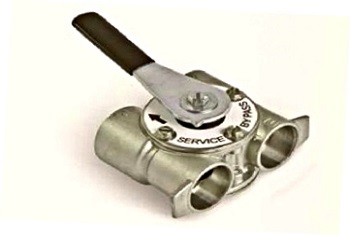
- A slider-type bypass slides a piston one way or the other to bypass the system.
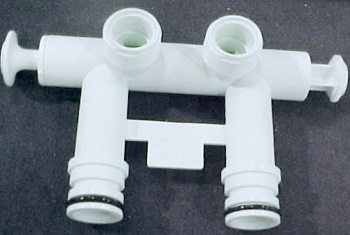
- A single knob bypass turns clockwise or counter-clockwise to bypass the system.
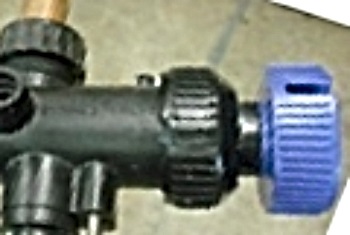
- A dual-knob bypass has two knobs or arrows that will bypass the system when both knobs are turned so that they are pointing towards each other. Be sure to turn both knobs when using a dual knob bypass as turning just one may result in no water going to the home.
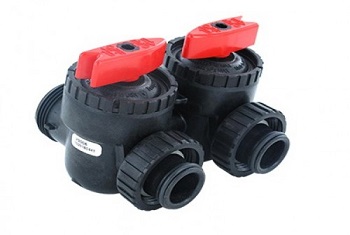
- A Three valve bypass has three valves that when the first and third are open and the middle one closed, the system is in service. If the middle one is open, the water is not being properly guided through the water softener.
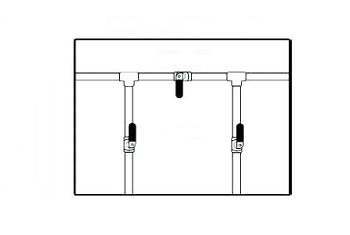
Check which kind of bypass you have and be sure that it is in the “Service” position. Remember that when a lever or knob is in the same direction as the pipe, the water is on. And when it is turned to the left or right, the water is shut off.
You may have a salt bridge?
A salt bridge occurs when the salt at the bottom of the brine tank dissolves away for use by the water softener, but the salt above it does not drop down into the water to be used for the systems next regeneration.
The salt bridge is formed by the salt dissolving slightly and then re-crystalizing, bonding multiple crystals together that support each other, much like an arch doorway made of stone or brick.
When you have a salt bridge, no salt is making contact with the water in the bottom of the brine tank, and therefore no brine is made. Brine is the strong salt solution that the water softener uses to remove the hardness from the softening resin that is in the tank.
If the hardness does not get cleaned from the resin, the resin will not be able to remove more hardness as the water flows through it.
A salt bridge is generally an easy thing to clear, you simply need to break-up the salt so it collapses down into the water. Check out my article on How Do I Clear A Water Softener Salt Bridge?
You may have salt mush in your brine tank.
Another problem that you could have in your salt tank is a build-up of pellet salt mush. Pellet salt is formed with a binding agent that holds the salt together in the pellet shape that gives the salt its name.
Although pellet salt is considered to be very clean and is recommended by many manufacturers to be used with there systems, it does leave the non-water-soluble binding agent behind after the salt portion of the pellet has been dissolved.
This powdery binding agent sinks to the bottom of the salt tank, and over time it can build up to a deep layer of fine mush that takes up space where there should be a brine solution.
When this happens, the system will not get a sufficient dose of brine to clean off the hardness from its softening resin. This will result in the system not being able to remove hardness from the water for as long as it should.
The result is, the system will produce soft water for a while and then the water will be hard until the system regenerates. It is also quite difficult to remove because it is at the very bottom of the salt tank and is very compacted.
If this has happened in your salt tank, I find that the best way to remove it is by using your hands or perhaps a coffee can or scoop to shave off a little at a time from the top.
Add extra water if necessary to help loosen the packed down mush. I do not recommend using any sharp implements when cleaning out your salt tank, as you can easily punch a hole in the tank with just a little slip of the hand. A putty knife is handy, or even a large serving spoon.
A salt bridge can form with any kind of water softening salt that you use but I find it happens more frequently with small-sized salt crystals as they have more flat surfaces that make it easier for the crystals to create strong bonds between each other.
I still recommend using water softener salt crystals over pellets as they are very clean and will dissolve more completely than the pellets. If you do not over-fill your salt tank, a salt bridge is not likely to form.
Add salt when the tank is down to a quarter full, and fill it to about two thirds full and you should not have a problem with salt bridging. Check your softeners settings.
Sometimes if you have a power outage, even just a short one, your water softeners clock may have to be reset, or the hardness setting may be lost.
This doesn’t usually make a big difference, but if your softener is regenerating when lots of water is being used elsewhere in the home, it can be deprived of sufficient water pressure to properly regenerate the softening resin.
Also, when an electric water softener begins it’s regeneration process, the system is bypassed to prevent brine solution from getting into the home. This means that if you use water while the water softener is regenerating, you will get untreated, hard water.
This is why electric water softeners are usually programmed to regenerate at 2:00 in the morning, when most people are sleeping, and there is no water being used.
So if the time on your water softener is off due to loss of power, it may think that it is 2:00 am even though it is during the day. So the water softener will begin to regenerate and hard water will go passed the system, and into the home.
Also, the loss of power may result in the water hardness settings being reset back to the manufacturers’ default settings. You may have to reset the water softeners hardness setting to the hardness level of the water that you are treating.
Many digital water softeners have a manufacturers default setting of 20 grains per gallon. If your water has a hardness of more than 20 grains per gallon, you will likely experience hard water for a period of time before the system regenerates itself.
Both the time and hardness settings on most water softeners are quite easy to set. Setting the clock is much like sitting the time on an alarm clock. Press the clock or time button, use the up and down or + and – buttons to change the hour (don’t forget to get your AM or PM correct).
Then press clock or time button again and use the up and down or + and – buttons to change the minutes. Then press clock or time then up and down or + and – to change the day (if your system calls for it). And then press clock or time once more and then you are done.
Setting your hardness level usually has a few more steps than setting the clock, so check your owners manual and follow the appropriate steps to check your hardness settings.
If you don’t know your hardness or iron levels, you can get a simple water testing kit to test them yourself.
Is your water softener drawing the brine from the salt tank?
A water softener will not remove the hardness that it has collected from the softening resin in the tank if it does not get a strong dose of the brine solution that is in the salt tank.
Look in your salt tank, is the water level higher than you remember it being before? If so, the system may not be drawing all or any of the brine during its regeneration process.
This is often the result of a clogged injector and/or screen. The injector creates the draw that pulls the brine from the salt tank, if it gets clogged or restricted, it will not draw out the brine and therefore the softening resin will not get cleaned.
This injector can be cleaned, but you may want to call a professional service technician if you are not comfortable taking your water softener apart.
Your brine line fittings may be loose or you may have a crack in your brine line.
If the tubing that goes from your water softener to your brine tank becomes loose or develops a crack in it, it could be sucking in air. If your brine line is drawing air in then it won’t be drawing the brine as strong as it is supposed to.
If your water softener does not get a full-strength dose of brine solution, it will not remove all the hardness that has built-up within the tank, and therefore your water softener will not deliver softened water as long as it is supposed to.
Check your water softeners discharge hose.
If a water softener does not have a good flow going through it, it will not be able to draw out the brine solution from the brine tank and therefore not be able to remove the hardness from its softening resin.
Check your water softeners discharge hose for kinks, sharp bends or any type of obstructions that could inhibit the water flowing through the system.
If the water can’t discharge out of the water softener smoothly, it can’t come into the water softener smoothly. If you notice that your discharge hose is discolored or even black in color, do not be alarmed, it is a waste line so dirty water is going through it.
Even if you were to have it replaced, it would soon become darkened by the dirty water flowing through it.
You may have a problem with the water softening resin.
The water softening resin may have iron or other substance coated on it, preventing it from removing hardness. During the ion exchange process that removes the hard minerals from the water, iron and manganese will also be removed and will cling to the water softening resin.
The iron and manganese will normally be removed from the water softening resin during its regeneration process. But if the water softener is not getting a sufficient dose of brine solution, or if the water softening resin has been damaged by age or exposure to corrosive chemicals like chlorine, some of the iron and manganese can be left behind.
Over time, additional iron and manganese can attach itself to the existing iron or manganese already clinging to the water softening resin and collect on the resin itself.
Eventually, there will be a little surface area left on the softening resin beads for it to remove the calcium and magnesium in the water that makes the water hard. This will make the resin bedding very inefficient and in time, useless.
Can iron be cleaned from water softener resin?
If your water softeners are showing signs of hard water due to a build-up of iron in the water softening resin, it has probably gotten to the point where even cleaning the resin would not bring it back to its full ability to remove hardness from your water.
But if you have iron in your water and you are concerned about iron build-up on your water softeners resin, I highly recommend using water softening resin cleaner once a year to prevent the initial build-up of iron and manganese.
A yearly treatment with this water softener resin cleaner will help to remove any iron collecting on the resin. Using water softener resin cleaner is very easy and it can extend the life of your water softeners resin.
Many people treat their water softener resin once or even twice a year, it will do no harm to the system, it will only make sure that the resin is as clean as it can be.
Simply pour about 4 ounces of water softener resin cleaner into your water softeners salt tank, and that’s it.
The resin cleaner will mix with your brine solution at the bottom of the salt tank and the next time that your water softener goes through its regeneration process, the resin cleaner will wash over the water softening resin.
This combination of brine solution and resin cleaner will help to loosen any iron or manganese that has collected on the resin, helping it to soften your water as best as it can.
Hard water may be going through your water softening resin when it shouldn’t be.
As a water softener ages, the seals that control which way the water is channeled will get worn and sometime they will let untreated water continue to go through your water softener even after the regeneration cycle is finished and when no water is being used in the home.
This is not very common with electric water softeners that work using a piston that is driven by an electric motor, but it can happen occasionally with non-electric water softeners that rely on the homes water pressure to control all of its functions.
Have you seen any amber colored stuff in your water recently?
It may be your water softeners resin, and without the water softening resin, a water softener is just a big empty pipe. Occasionally the resin that is in your water softener can get washed out of the tank and end up in your sinks, toilets, and showerheads.
It is tiny beads and has a brown amber color, a bit like week coffee or tea. Inside most water softeners tanks is a basket that allows your water to flow through but keeps the water softener resin from coming out of your tank.
Over time these baskets can get cracked, allowing the water softeners resin to escape from the tank and get washed into the home.
They will settle in the storage tanks of your toilets, in the flexible lines that feed your toilets, in the screens on the ends of your faucets, in the holes of your showerheads, and down the drain from your water softener.
This often happens due to water pressure in the home being too high and the water softening resin continually being pressed up against the water softeners basket.
Once the basket has cracked, and the resin has escaped the tank, it can be a rather expensive procedure to have a professional come out and replace the basket and re-bed the resin.
You may notice a drop in water pressure at the same time that you notice that your water no longer feels soft. This is because the water softening resin gets in the screens of your faucets and blocks the flow of water.
Your showerhead might start spraying unevenly, with streams shooting out in irregular directions. This is caused in part by clogging of the jets and the water channeling through at an angle.
Your water pressure to the water softener may be to low.
A water softener with low water pressure going to it is a bit like a vacuum cleaner that can’t create a strong enough vacuum to pull the dirt up from the floor.
If a water softener does not have sufficient water pressure, it will not have a strong enough flow to create a draw to pull the brine solution from the salt tank.
Without brine solution, the water softener can not remove existing hardness from its resin, and therefore can not remove any more from the water flowing through it.
A minimum of 20 PSI (Pounds per Square Inch) of pressure is required for most water softeners to function correctly. Check your homes water pressure to be sure you are getting sufficient water flow to your water softener.
There should be a small gauge on your homes pressure tank if you are on a well, or there might be one by your water meter if you are on a municipal water system.
It may not be your water softener running at all.
I have come across many people that have thought that they knew what their water softener sounded like but it turned out that it was some other system running in their home that they always had thought was the water softener.
Often, water softeners are installed in the same room or in the same general location as many other utility systems for the home. When a person is used to hearing noises from that location, they might not actually know which one of their systems are running.
Water softeners usually are not all that loud. From a distance or another level of the home, one utility system can often sound very similar to another.
Many people tell me that they think that their water softener operates every night when in reality it is only running once a week. This situation usually boils down to the settings on the water softener being incorrect.
For example, it may be that your water softener is supposed to be regenerating every three days or so but you experienced a power outage recently and the water softener reset back to its original factory settings which are insufficient for your water situation.
Is your water softener regenerating enough?
Your water softener may not be set to regenerate often enough to provide a steady supply of soft water to the home, which would explain the hard water.
And if another sound in the home is often being misinterpreted as being the water softener operating, this would explain why you might think that the water softener is operating as usual. The drive motor may be making a loud noise, but the water softener is not working.
Most electric water softeners use an electric motor to control the units main piston. As this motor gets older, it can start to make a whining type noise because it has been straining to move the water softeners piston for a long period of time.
The electric motor can make this noise for a long time and it can get louder over time. Sometimes even a brand new motor can make a louder noise than one that has been replaced.
But keep in mind that just because the drive motor may be making a lot of noise, does not mean that it needs to be replaced. If your water softener is not going through its regeneration process, but it is making a loud noise like it is, checks to see if the drive motor is advancing the water softeners cycles.
If you are a do it yourself kinda person, most drive motors are relatively inexpensive and can be replaced very easily. Unplug the water softeners power supply and then you can replace the drive motor.
Start by simply removing a few screws that hold the motor in place and disconnecting the old motor electrical wires. Then just twist in the new motors wires and remount the motor the same way as it came off.
After replacing the drive motor, plug the water softener back in and reset the clock. Check your water softeners setting and correct them if need be.
Most water softeners have a battery back-up in them, so your original system settings should still be in the system’s memory.
Related Questions:
Why does my water softener sound different sometimes? During a water softeners regeneration process, there are several cycles that it will go through in order to complete its water softening task.
There are normally between three and five cycles, and the different cycles are using water at different flow rates. The cycles that use a very high amount of water with a very strong flow of water will sound much louder than the cycles that have a slower rate of flow.
Somewhere about in the middle of the water softeners process is what’s commonly called the brine rinse cycle. This cycle is usually relatively quiet compared to the other cycles and can last up to an hour and a half.
This quiet brine rinse cycle is what most people think of when they think of their water softener running, but there is normally a much louder backwash cycle before and after this cycle, which sometimes sounds like the water softener is not functioning properly.
Why is my water softener running constantly? If your water softener is running non-stop day and night, first of all, get the system bypassed to stop the water going through it. If your water softener is running continuously, it is because it is not able to continue to the next cycle in its regeneration process.
This is often caused by the system losing power, and therefore not able to advance the main piston that controls which cycle it is in.
If the water softener has not lost power but still continues to run water through it, it may be because the motor that moves the piston that controls the cycles has stopped working or is not able to move the piston as it should.
This may be because of the main piston being stuck in one position because of iron or debris build-up within the pistons chamber. If the piston is no longer able to move freely, it will have to be replaced along with the seals that keep the water from going to multiple channels within the piston chamber.
Sometimes a water softener will continue to run water through it because of these piston seals getting worn and allowing water to get out through channels that it is not supposed to.
This problem also requires the piston and seals to be replaced but sometimes the chamber itself has gotten worn. In this case, the whole water softening valve will usually need to be replaced.
This can be a bit on the expensive side, so be sure to compare the cost of repair and cost of replacement before continuing.

